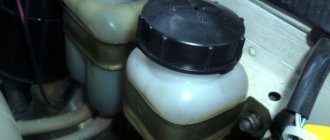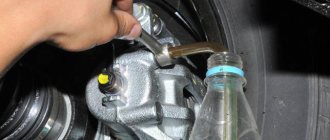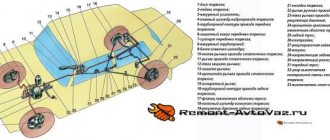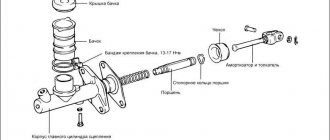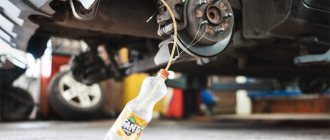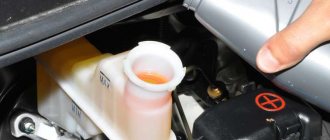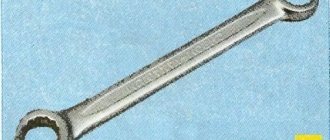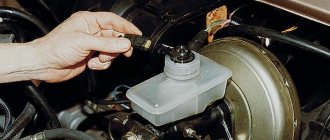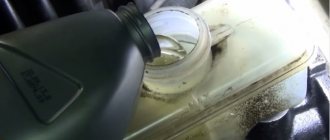In the cold weather, the problem with the transmission, or more precisely with the clutch, returned. We fix the problem ourselves. In cold weather, the problem with the transmission returned; when driving in an outside temperature below -20 degrees, after pressing the clutch pedal, it very slowly returns to its original position, and when pressed it is tighter than usual. I encountered this problem last winter, but since the OD is very far from me, I decided to contact it when passing TO-1. The maintenance took place while on vacation and of course I forgot about this problem, since it was already summer and here it is again. TO-2 is still 3000 km away, it’s a long and expensive trip to the dealer, so I decided to handle it myself. The root of the problem most likely lies in poor-quality brake fluid or in non-compliance with its storage conditions. Brake fluid tends to absorb moisture, and this moisture is what causes the clutch to not work correctly and “stick” in cold weather. And so, on JR5 gearboxes, the clutch is hydraulically driven, the reservoir with hydraulic fluid is shared with the brake system. A decision was made to replace the brake fluid of the entire system; the work must be carried out with a partner. For this purpose, two liters of DOT-4 brake fluid were purchased; you will also need a 8mm wrench, a syringe for pumping out old fluid from the reservoir, a transparent thin hose of the required diameter and a container for draining the old fluid:
We begin the work by pumping out the old fluid from the reservoir: Next, you need to fill the reservoir with fresh fuel fluid and begin pumping the brake system, starting with the far wheel of a longer circuit. Remove the rear right wheel if there is no lift or inspection hole:
On the back of the drum, we find the drain fitting with a rubber cap on, remove the cap:
We put a 8 key on the fitting, if it is a cap, and then a hose, the second end of which we lower into the drain container:
We pump the circuit as follows. The partner presses the brake pedal 4-5 times and leaves it pressed. After this, you need to slightly unscrew the drain fitting, turning it counterclockwise 1/3 of a turn, while the old fuel fluid will begin to flow out of the hose, and the brake pedal will sink to the floor. Then we tighten the fitting, and the partner repeats the pumping procedure. We repeat until the old fluid is completely drained, which was much darker than the fresh one (light fluid will come out of the hose). Next, install the wheel and move to the front left wheel:
Don’t forget to add fuel fluid to the tank so as not to air the system:
Then we repeat everything with the rear left and then the front right wheels, do not forget to put rubber caps on the fittings. We're done with the brake circuits, now we need to bleed the clutch circuit. The work was carried out through the top, throwing off the air filter duct. The fitting is located under it, 30-40 cm lower:
Remove the rubber cap and put on the hose:
We lower the second end of the hose into the container:
Your partner pumps the clutch pedal 10-15 times and releases it, in the meantime you need to press the spring lock
Anti-lock braking system ABS: types, types
Depending on the type and type, ABS is classified into:
- One scheme of operation of the ABS system is when all the devices that make up the ABS are located in one unit. That is, the hydraulic valve block, hydraulic accumulator and pump are located in one unit.
- The second ABS scheme is when the component devices (hydraulic valve block, hydraulic accumulator and pump) are located in different places. In this type of braking system, in addition to the ABS module, there is also an ESP module and an SBC module.
Whether you can bleed the brake system yourself depends on what type of brake system is in your car.
If the car has a system of the first type, then it is easy to properly pump the ABS.
If the car has a system of the second type, then one cannot cope without a scanner; it needs to be pumped to a service center for maintenance.
The ABS system consists of:
- Sensors (installed on the hubs). When replacing rear wheel hubs, as well as some front ones, you may notice special recesses for sensors. They are engaged in transmitting data about the speed of movement.
- Control valves (installed in the brake system). Serve to change the pressure in the system.
- The electronic unit. Receives speed information from sensors and adjusts control valves.
What kind of oil to fill in the power steering of Renault Logan
Car manufacturer Renault Logan has equipped some configurations of its line with such a useful and driver-friendly option as power steering. Oil is poured into such a system, just like into an engine, and over time it will also need replacement. Novice car enthusiasts have never asked such a question and have no idea what oil is suitable for car steering systems. In this article we will talk about this.
When is it official to change?
40,000 kilometers or no more than 2 years - regulations for replacing power steering fluid
The regulations from the official dealer state that the oil that is poured directly from the factory into Renault Logan is designed for a mileage of 40,000 kilometers or no more than 2 years of operation, whichever comes first.
In what cases may it be necessary to replace it ahead of schedule?
Details about a complete oil change in the power steering system for Renault Logan!
However, it is necessary to monitor the condition of the oil in the power steering expansion tank at every stage of vehicle maintenance. To change the oil outside the stipulated time frame, the following will apply:
- Metal trash
- Dark liquid color
- Unpleasant smell
For comparison, a drop of new oil (circled in blue) and a couple of drops of drained power steering oil
And also, for immediate repair and inspection of the entire steering system, there will be an insufficient level of power steering oil in the expansion tank, because if this malfunction occurs, the oil temperature will quickly increase, and the mechanism itself will fail.
The gearbox also needs regular checking of the oil level, but there’s no need to talk about checking the engine oil level!
Advice! If, while driving a car, you feel like the steering wheel has become difficult to turn, and it has become like oak, noise or an extraneous hum has appeared. Go to the specialist immediately. Because a breakdown of the power steering can result in, at best, a breakdown of the steering mechanism, and in the worst case, it can cause a traffic accident.
What kind of oil do we fill into the hydraulic booster?
For comparison, Dacia recommends the RENAULTMATIC D2
For stable operation and reliability during operation, the manufacturer recommends replacing fluid with a synthetic or semi-synthetic base of the D2 ATF or PSF standard.
Such oils have optimal viscosity and density and are designed for operation at ambient temperatures down to -36° C, which is quite suitable for winter weather conditions in Russia.
The service book “recommends” ELF RENAULTMATIC D2
To completely change the power steering fluid, the manufacturer recommends ELF RENAULTMATIC D2 oil for Dexron II class, which is indicated in the service book for any Renault Logan car.
However, if your car is subject to constant load on the steering, constant temperature changes, then in this case it will be important to use standard D3 fluid, or Elf Renault Matic G3.
There is constant debate about the use of oil in power steering D3 or G3! Take this into account when choosing, since Renault “does not approve” of such a replacement. Some Renault Logan owners notice improvements in the performance of the power steering, while others do not. This is a reason for discussion, what do you think about this?
Replacements (analogues)
In addition to what is recommended, Renault allows the replacement of fluids from other manufacturers that meet all the requirements and are similar to the original:
- Mobil ATF 220 (320).
- Liqui Moly ATF 1100.
- Castrol ATF D2 (D3).
One of the options for an alternative power steering oil change
It is necessary to pay special attention that mixing different types of liquid is not allowed. Otherwise, it will foam and the entire power steering mechanism may fail.
Therefore, such an operation may require a complete oil change. You can read about the nuances of such work and the process on our website in this article.
Follow maintenance rules
Compliance with such simple rules and tips for maintenance, inspection of the steering system and selection of the recommended power steering fluid for Renault Logan will certainly have a positive impact on the general condition of the control systems and the car as a whole. This will not only save money on unexpected repairs, but will significantly reduce the risk of an accident on the road.
ABS bleeding sequence
- First, we look for and remove the fuse in the fuse block that is responsible for the operation of the anti-lock braking system.
- Next, we jack up and remove one front wheel, and look for the brake wheel cylinder (BWC) fitting.
- After this, we put a hose on the fitting (from a hydraulic level, for example).
- Open the fitting one turn.
- One presses the brake pedal all the way and holds it in that position.
- Now turn the ignition key to turn on the hydraulic pump (the ABS indicator lights up on the instrument panel).
- The second person watches how air is removed through the hose and, after removing the air, tightens the fitting.
- We release the brake pedal only after tightening the fitting.
- Now, how do you know that all the air has escaped from the ABS? This shows the ABS icon on the dashboard, if it goes out after removing the air and tightening the fitting, then all the air has escaped.
The correct sequence for bleeding the ABS system
There is a special order for properly bleeding an anti-lock brake system: right front wheel, then rear, then rear right, and then rear left wheel. If during such work the fuel fluid leaks out of the system, it is necessary to fill the system with new fluid. And to do this, you need to know what fluids can be mixed and how much brake fluid is needed to replace.
How to bleed brakes in the field
What if you don’t have the necessary material on hand to modify the brake fluid reservoir cap? We return to the standard method of bleeding the brakes:
- Press the brake pedal several times until it becomes firm;
- We place a pry bar or any other tool of suitable length (for example, a stick) between the seat and the brake pedal;
- We unscrew the brake fitting and watch how the brake fluid comes out along with air bubbles;
- We repeat the process for each wheel starting from point No. 1.
In all cases of bleeding the brakes, monitor the fluid level in the reservoir. If you can’t unscrew the fitting, spray WD-40 on it and wait a couple of minutes for it to dry out.
If the brakes do not bleed, the system is not sealed or one or more components, such as the master cylinder or pipe, are faulty. Also, do not forget to flush your car's brake system on time.
How do you bleed the brakes on your car? Let us remind you that it is convenient to search for other operating and repair instructions by content for each Lada model: Granta, Kalina, Priora, Vesta, Niva, Largus or XRAY.
Keywords: lada xray brakes | Lada Vesta brakes | Lada Largus brakes | Lada Granta brakes | Lada Kalina brakes | Lada Priora brakes | 4x4 brakes | Niva brakes | universal article
3
0
Conclusion
After carrying out repair and maintenance work on critical components of the car, before driving, you must first check the tightness of the system and the operability of the vehicle components.
ABS - Anti-lock Braking System is a system against wheel locking during heavy braking. Thanks to the fact that ABS prevents the car from skidding along the road, safety increases in emergency situations. The anti-lock braking system will operate correctly if the system is not air-filled.
Watch this helpful video. Tests show that even a working ABS system turns off at the end of the braking distance, so you still need to modify it with your foot.
Bleeding the Brakes Main Section If there has been a brake fluid leak or if air has entered the system, the system must first be cleared before proceeding further. Place the car on a level surface, start the power unit and engage first gear or reverse gear on models with a manual transmission (on models with an automatic transmission, place the selector lever in the “P” position). After this, place the bars under the wheels and turn off the handbrake. Bleeding air from the brake system If the fault is in only one circuit of the hydraulic system (it has a diagonal branch on samples without ABS and a front and rear branch on samples with ABS), then bleeding will only be necessary in the corresponding circuit. In the case of the main brake cylinder (its disconnection or connection), if the brake fluid level has dropped significantly, it is necessary to remove air from the entire system, observing the following sequence.
For models without ABS system: a) right front brake; b) right rear brake; c) left front brake; d) left rear brake.
Mechanical damage
The next point of troubleshooting will be a visual check of the hoses of the car's braking system: there should be no signs of leakage at the hose connections and on the car parts.
Often the cause may be a poorly tightened screw connection. You should also check the places where the pipes are attached to the cylinders on the brake discs: if this problem is detected, use an 8 mm wrench to tighten all the nuts that secure the pipes.
All hoses must be intact, without cracks or kinks. If this malfunction is detected, such hoses must be replaced with new ones. It is also worth paying attention to the condition of the master cylinder gasket - there should also be no signs of leakage or breakage on it.
The degree of wear of brake pads and brake discs also plays a special role. There should be no signs of wear on these system elements; the pads should not be worn down to metal. All these elements must be changed in a timely manner.
2283-4-22-04 (Copy)
It is necessary to bleed the brake system hydraulic drive until new fluid (lighter than the old one) begins to come out of the bleeder fittings of all working cylinders.
We carry out pumping to replace the fluid with the engine not running, first on one circuit, and then on the other in the following sequence:
- right rear wheel brake;
- left front wheel brake mechanism;
- left rear wheel brake;
- brake mechanism of the right front wheel.
Why is replacement needed?
Many people do not know why it is necessary to replace brake fluid on a Renault Logan, because the car works well, and the fluid itself is used in closed circuits. But in fact, the properties of technical fluids change over time.
If water gets into the lines, it can cause corrosion. And in winter, drops of condensate can freeze and break the line. The more water in the working fluid, the lower the boiling point and the higher the viscosity. The permissible water content is 3%. At the same time, the temperature drops to 165 degrees.
If the permissible percentage of water is increased and the boiling point decreases, this will lead to a one-time failure of the brake system. Then it can work quite correctly. It is very dangerous. This symptom indicates that a vapor lock has formed inside the brake line due to heating of the brake fluid. This is the so-called invisible brake failure - at first the car does not want to slow down, and then everything works as expected.
2283-4-24-02 (Copy)
An assistant must vigorously press the brake pedal all the way 1-2 times and keep it pressed.
In this case, liquid will flow out of the hose, and the brake pedal should be pressed all the way.
As soon as the liquid stops flowing from the hose, tighten the fitting, and only after that can the assistant release the pedal.
We repeat this operation until new brake fluid (lighter than the old one) comes out of the fitting.
We remove the hose, wipe the bleeder fitting dry and put a protective cap on it.
Remove the protective cap from the brake bleeder fitting of the left front wheel.
We put a hose on the fitting, and immerse its free end in a container partially filled with working fluid.
Why did it happen so?
Perhaps the automatic requests do not belong to you, but to another user accessing the network from the same IP address as you. You need to enter the characters into the form once, after which we will remember you and be able to distinguish you from other users exiting from this IP. In this case, the page with the captcha will not bother you for quite a long time.
You may have add-ons installed in your browser that can make automatic search requests. In this case, we recommend that you disable them.
It is also possible that your computer is infected with a virus program that is using it to collect information. Maybe you should check your system for viruses.
If you have any problems or would like our support team, please use the feedback form.
LADA > Largus
Which brake fluid to choose for Priora
The manufacturer fills it with DOT 4. The most popular brake fluids among buyers are ROSDOT 4 and NEVA-M. The first option is more expensive, the second is cheaper. For cars with and without ABS, it is recommended to use different types of fluids.
- DOT-4 plus for vehicles without ABS
- DOT-4 class 6 is designed for modern braking systems (ABS, ESP, VSA)
Depending on the capacity, the cost of the brake fluid indicated above is from 50 to 150 rubles.
You can also add DOT 5.1 fluid. It has a lower viscosity than the above samples, as well as a higher boiling point and, according to manufacturers, changes once every five years.
It is prohibited to mix liquids of different types with each other!
Lada Largus 2015, engine Gasoline 1.6 liter., 102 hp, Front drive, Manual — vehicle inspection
Comments 16
But most people have seen the line on the antifreeze expansion tank, is this a flash mob? I have one drawn like this too.)))
No, this is from the factory, all bolts, nuts and the level of filled liquids are marked by the factory's quality control department
Did the device help with pumping?
Of course, without her help it’s problematic to be alone.
check the brake hoses, according to the regulations they are also 5 years old
a tube with a non-return valve, put 4 containers and add more pressure, wouldn’t it be easier?
Well, yes))) take off 4 wheels at once to gain access to the fittings. Finding 4 containers with 4 hoses with check valves is MUCH easier)))
I also needed to bleed the clutch. We have one reservoir for both brakes and clutch. So download again. Dirt comes out of the clutch as soon as I started, and I then checked for moisture and pumped it again.
I forgot about the clutch))
I thought there was a separate tank there. Then he spat. Brakes 1 liter at a time to the wind. According to measurements, dirt adhesion and hydroscopicity are much lower than normal. There is a device that measures moisture in the brake fluid.
Yes, there is a device, but I decided to change it anyway since the service life of the liquid has expired anyway
Speaking of liquid. Test the new one before use. I picked up a turtle from the Dot4 store and it was already filled with water. The truth is not yet in the red zone.
Yeah. Well done you. Actually, not everyone reads the comments, correct the article)
I also changed it according to these instructions. And now I’m sitting and wondering why my fluid is dirty again)) Can you please provide a link to the replacement instructions?
In what order should the changes be made taking into account the clutch? Clutch at the end or no difference?
Not everything is so simple there. The clutch is powered from the same tank as the brakes. There is a separate compartment in the tank. I pumped out the dirty stuff as best I could with a syringe and then put pre-purchased silicone hoses (to a construction store) on all the brake releases, placed the bottles and the liquid flowed by gravity. At this time, the syringe with a silicone tube was put on the clutch. And having opened the pump, I pumped out the clutch with a syringe (I took 200 ml, I don’t know why). The second person monitors the level and adds quietly. It took a long time, but clear liquid began to accumulate in the tank. Then I shut everything off and bled the brakes. Because the clutch was pumped with a syringe without bubbles and it ran clean. Oh yes, the brake ones are also transparent. 2.5 liters of fluid gone
Yes, I also see someone pumping the clutch pedal, someone pumping it out with a syringe, but it seems like using a syringe is more correct. As I understand it (but I’m not sure yet), this does not have to be done simultaneously with the brakes. And by and large, it doesn’t matter what to bleed first - the clutch or the brakes. But since this is the top contour, it is logical to do it last.
While the brakes were dripping by gravity, I ran the clutch through with a syringe. Then, adding fresh transparent fluid to the reservoir, I realized that there was clean brake fluid in there. Well, then we started pumping the brakes.
What is brake fluid used for?
To understand why brake fluid is needed, you need to understand where it is used in the car.
Brake fluid is used in the main components of the car, namely the clutch system (if a manual transmission) and the brake system.
The operation of one or another system is based on two cylinders - the main and the working. They are connected to each other by special copper tubes through which the brake fluid passes.
When squeezing the master cylinder, the fluid flows forward through the pipes, thereby squeezing the working cylinder.
Brief excursion
In numerous videos presented on the Internet, you can see this car, get acquainted with its characteristics and watch test drives. The spacious interior and large trunk are impressive, which is very useful for Russians - especially those who like to travel outside the city.
In 2010, Lada Largus was first presented to the public. After 2 years, the first car rolled off the assembly line and industrial production began. The car itself is a copy of the Dacia Logan MCV, presented under license for production at AvtoVAZ. Nowadays, several modifications of the Lada Largus are produced: with a station wagon body capable of accommodating 5 or 7 passengers, as well as with an all-metal body and a 2-seater saloon.
The car is equipped with two French injection engines with a volume of 1.6 liters - with 8 valves and a capacity of 87 hp. s., as well as a 16-valve engine with a capacity of 105 horses. A 16-valve engine has two camshafts, an 8-valve engine has one. The car is made on the Renaul Logan platform, and the engines are also taken from there. Transmission – manual 5-speed, French.
In the video you can see how the Lada Largus confidently moves along our roads. This became possible because the suspension, springs and shock absorbers are adapted to Russian road conditions and are designed for increased load capacity. Increased ground clearance also contributes to good cross-country ability.
What kind of engine oil should I fill in Lada Largus? It can be from different brands, but must strictly comply with the manufacturer’s specifications. The requirements for the 16-valve K4M engine are as high as possible. It is better to fill in the engine oil that is used at the factory when the car was produced.
Until recently, during the first refueling, ELF SOLARIS RNX 5W30 was poured into the engine. Before this there was LUKOIL Genesis RN 5W40. The latest official information from the manufacturer states: the first filling is carried out with ELF EXCELLIUM NF 5W40 lubricant. As you can see, in both last cases the oil characteristics are 5W40, which is what needs to be taken as the basis for further operation.
Please note that 5W30 oil is less viscous than 5W40. Renault advises refilling a 16 valve engine with ELF EVOLUTION SXR 5W40. But for an 8-valve engine, a 5W30 oil change is recommended. This is due to the fact that the more viscous 5W40 is better suited to hydraulic valve compensators. Therefore, whatever the lubricant is, it must have such characteristics.
There is no consensus among car enthusiasts regarding 16-valve engines. AvtoVAZ also does not have a clear position on this issue. Its first digit depends on the operating temperature: 0, 5, 10 or 15. For low temperatures from -30°C you need to use 0W, for moderately low temperatures (from -25°C) - 5W, etc. For all of the above cases a viscosity of 30, 40 or even 50 is required. In the presented video you can hear all the explanations why 40 or 50 cannot be poured into an engine designed for a lubricant viscosity of 30, even if it already has a good mileage.
The properties of the lubricant must comply with API SL/ API SM/ API SN. Requirements for the ash content of oil in a 16-valve engine are ASEA A1/ ASEA A2/ ASEA A3/ ASEA A5. The brands are not named, that is, you can pour in the motor oil that you subjectively like best. Now there is a new, most suitable modification on sale - ELF EVOLUTION 900 SXR 5W40. Surely it is produced with other parameters in terms of temperature and viscosity. How much lubricant should I buy? Replacement in Lada Largus requires from 4.6 to 4.8 liters of lubricant, the engine crankcase is designed for 5 liters.
How to remove and replace a brake disc on a Lada Largus
So, the first thing you need to do is remove the wheel bolts, and then jack up the front of the car. Next, remove the wheel and caliper assembly. After this, you can begin to carry out this repair directly.
For greater clarity, it is worth looking at the report below.
Photo report of the work done on removing and installing brake discs on Largus
So, when the caliper is removed and nothing else bothers us, we need to unscrew the two screws that secure the disc to the hub using a torx t 40 bit.
If the disc is stuck to the hub, which often happens, then you need to tap the contact point with a hammer, as shown in the photo below.
When the disk has already moved away from its place, you can remove it without any problems:
Before you start replacing the discs, you must thoroughly clean the junction with the hub with a metal brush.
And also apply copper grease, which prevents vibration during braking, and also allows you to easily remove the disc in the future.
And now you can install the new Largus brake disc in its place. The minimum price for these Lada Largus parts is from 2000 rubles per unit. Accordingly, the kit can cost you from 4,000 rubles. Of course, the original will cost around 4000-5000 rubles.
Surely, many motorists are concerned with questions: how often do you have to change the front pads of a Lada Largus, what should you pay attention to when replacing them, do they only affect the reliability of braking, or is a new product not always a panacea for all ills. Naturally, everything is not so simple and, when changing pads, it is advisable to remember a couple of good tips.
